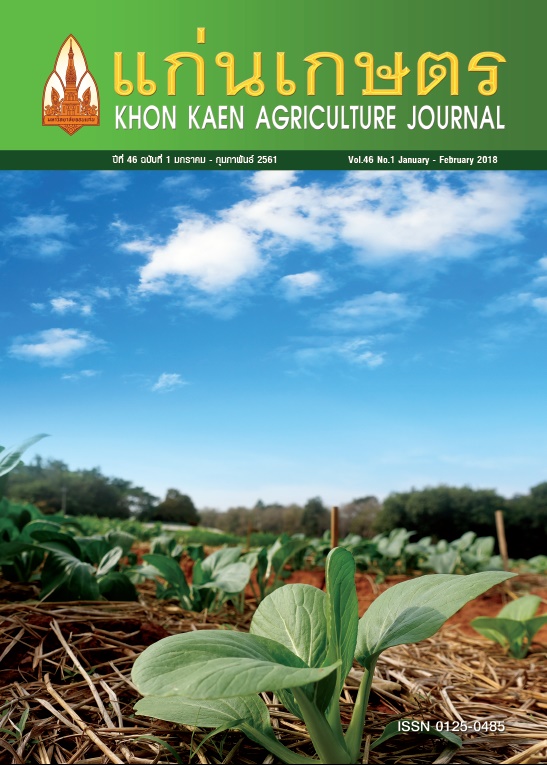ผลของสูตรอาหารและสารควบคุมการเจริญเติบโตต่อการชักนำให้เกิดแคลลัสในข้าวไร่พันธุ์ดอกพะยอม
Main Article Content
บทคัดย่อ
ข้าวไร่พันธุ์ดอกพะยอมเป็นข้าวพันธุ์พื้นเมืองที่เหมาะสมต่อการปลูกในภาคใต้ของไทย ปัจจุบันการปลูกข้าวไร่กำลังลดจำนวนลง จึงได้ศึกษาวิธีการขยายพันธุ์เพื่อการอนุรักษ์พันธุกรรมต่อไป จากการนำเมล็ดมาชักนำการเกิดแคลลัสบนอาหารสูตร MS ½MS และ N6 ภายใต้สภาวะปลอดเชื้อ เป็นเวลา 4 สัปดาห์ พบว่าให้อัตราการเกิดแคลลัสเฉลี่ยสูง 75.56%, 62.23% และ 46.67% ตามลำดับ อย่างไรก็ตามขนาดของแคลลัสจากอาหารสูตร ½MS มีขนาดเฉลี่ยใหญ่ที่สุด คือ 1.12 ซม. และจากการเพิ่มปริมาณแคลลัส โดยการเพาะเลี้ยงบนอาหารสูตร ½MS ที่เติมสารควบคุมการเจริญเติบโต 3 ชนิด คือ 2,4-D NAA และ BA ที่ความเข้มข้นต่างๆ เป็นเวลา 4 สัปดาห์ พบว่าที่ความเข้มข้น 1 มก./ล. และ 1.5 มก./ล. แคลลัสเพิ่มปริมาณได้ดีมีน้ำหนักเฉลี่ยสูงสุดคือ 1.03 และ 0.93 กรัม ตามลำดับ สำหรับการชักนำให้มีการพัฒนาเป็นต้นบนอาหารสูตร MS ที่เติม BA Kin และ NAA ความเข้มข้นต่างๆ เป็นเวลา 4 สัปดาห์ พบว่าอาหารที่เติม BA ความเข้มข้น 2 มก./ล. ร่วมกับ Kin ความเข้มข้น 0.5 มก./ล. และ NAA ความเข้มข้น 0.5 มก./ล. สามารถชักนำการเกิดต้นได้ดีที่สุดเฉลี่ยร้อยละ 20
Article Details
เอกสารอ้างอิง
จุฑาทิพย์ ทนันไชย, สงวนศักดิ์ ธนาพรพูนพงษ์ และสุชาดา เวียรศิลป์. 2556. ผลของ 2,4-D และไคเนตินต่อการเกิดเอ็มบริโอเจนิกแคลลัสในข้าวพันธุ์ขาวดอกมะลิ 105. วารสารเกษตร. 29: 177-185.
ปิยะดา ตันคสวัสดิ์ และ อารีย์ วรัญญูวัฒน์. 2551. ปฏิบัติการเพาะเลี้ยงเนื้อเยื่อพืช. เอเจนเทคจำกัด, กรุงเทพฯ.
พิจิกา ทิมสุกใส และ อารีย์ วรัญญูวัฒก์. 2548. สูตรอาหารเพาะเลี้ยงแคลลัสข้าวไทย. ว.ราชภัฏสกลนคร. 2: 24-29.
รังสฤษฏ์ กาวีต๊ะ. 2540. การเพาะเลี้ยงเนื้อเยื่อพืช. สำนักพิมพ์มหาวิทยาลัยเกษตรศาสตร์, กรุงเทพฯ.
สมพร ประเสริฐส่งสกุล. 2549. การเพาะเลี้ยงเนื้อเยื่อกับการปรับปรุงพันธุ์พืช. ภาควิชาวิทยาศาสตร์ คณะวิทยาศาสตร์และ เทคโนโลยี. มหาวิทยาลัยสงขลานครินทร์ วิทยาเขตปัตตานี. 127 หน้า.
Abe, T., and Y. Futsuhara. 1986. Genotypic variability for callus formation and plant regeneration rice Oryza sativaL. Theor. Appl. Genet. 72: 3-10.
Agarwal, P.K., S.S. Gossal, and S.G. Sidhu. 2006. Sequential reduction of 2,4-D improves whole plant regeneration from long-term maintained calli in some indica cultivars of rice. Oryza. 43: 10-15.
Azria, D., and P.L. Bhalla. 2000. Plant regeneration from mature embryo-derived callus of Australian rice (Oryza sativa L.) varieties. Australian J. Agri. Res. 51: 305-312.
Chen, T.H., L. Lam, and S.C. Chen. 1985. Somatic embryogenesis and plant regeneration from cultured young inflorescences of Oryza sativa L. (rice). Plant Cell Tissue Organ Cult. 4: 51-54.
Chu, C.C., C.C. Went, C.S. Sun, C. Hsu, K.C. Yin, C.Y. Chu, and E.Y. Bi. 1975. Establishment of an efficient medium for anther culture of rice throuth comparative experiment on the nitrogen sources. Science Sinica. 18: 659-668.
Gonzalez, M.C. 2000. Effects of different growth regulators on In vitro culture of rice cv. Amistad-82. Cultivos trop. 21: 23-27.
Gul, N., Z.A. Swati, S.M.S. Naqvi, I. Ullah, and A. Quraishi. 2000. Magnitude of Somaclonal variation in Oryza sativa L. cvs. Basmati-385, JP-5, Pakhal and Swat-II. Plant Tissue Cult. 10: 119-124.
Henke, R. R., M. A. Mansur, and M. J. Constantin. 1978. Organogenesis and plantlet formation from organ and seedling-derived calli of rice (Oryza sativa). Physiol. Plant. 44: 11-14.
Hopkins, G.W. 1999. Introduction to plant physiology. John Wiley and Sons, Ltd.
Hussain, Z., M. H. Khan, R. Bano, H. Rashid, and Z. Chaudhry. 2010. Protocol optimization for efficient callus induction and regeneration in three Pakistani rice cultivars. Pak. J. Bot. 42: 879-887.
Islam, M. M., M. Ahmed, and D. Mahaldear. 2005. In vitro callus induction and plant regeneration in seed explant of rice (oryza sativa L.) RJABS. 1: 72-75.
Ling, D.H., W.F. Chen, and Z.R. Ma. 1983. Somatic embryogenesis and plant regeneration in an interspecific hybrid of Oryza. Plant Cell Reports. 2: 169-171.
Murashige, T., and F. Skoog. 1962. A revised medium for rapid growth and bioassays with tobacco tissue culture. Physiol Plant. 15: 473-497.
Naqvi, S.M.S., R. Sultana, and H. Rasheed. 2005. Tissue culture studies in Oryza sativa L. cvs. Basmati-385 and Super Basmati. Pak. J. Bot. 37: 823-828.
Niroula, R.K., B.P. Sah, H.P. Bimb, and S. Nayak. 2005. Effect of genotype and culture media on callus induction and plant regeneration from matured rice grain culture. J. Inst. Agri. Anim. Sci. 26: 21-26.
Rashid, H., A.Toriyama, K. Qurashi, and K. A. Malik. 2000. An improved method for shoot regeneration from calli of Indica rice. Pak. J. Biol. Sci. 3: 2229-2231.
Shahsavari, E., A.A. Maheran, A.S.N. Akmar, and M.M. Hanafi. 2010. The effect of plant growth regulators on optimization of tissue culture system in Malaysian upland rice. Afr. J. Biotechnol. 9: 2089-2094.
Taiz, L., and E. Zeiger. 2002. Plant physiology. The Benjamin/Cummings Publishing Company, Califonia. Upadhyaya, G., M. Sen, and A. Roy. 2015. In vitro callus induction and plant regeneration of rice (Oryza sativa L.) var. ‘Sita’, ‘Rupali’ and ‘Swarna Masuri’. AJPSKY.5: 24-27.
Wani, S.H., G.S. Sanghera, and S.S. Gosal. 2011. An efficient and reproducible method for regeneration of whole plants from mature seeds of a high yielding Indica rice (Oryza sativa L.) variety PAU 201. N. Biotechnol. 28: 419-421.
Yan, L.N., L.l. Xia, and W.U. Dan. 2010. The comparison in tissue culture ability of mature embryo in different cultivars of rice. Agric. Sci. China. 9: 840-846.


